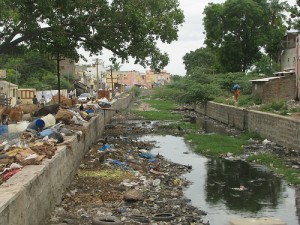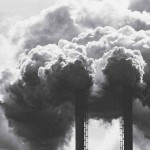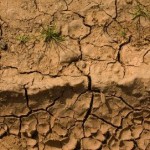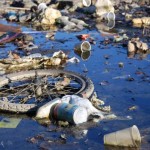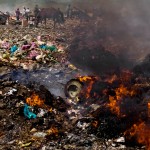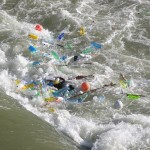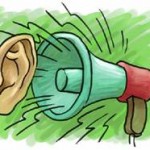Dr. V.K.Maheshwari, M.A. (Socio, Phil) B.Sc. M. Ed, Ph.D. Former Principal, K.L.D.A.V.(P.G) College, Roorkee, India
Mrs Sudha Rani Maheshwari, M.Sc (Zoology), B.Ed. Former Principal.A.K.P.I.College, Roorkee, India
Pollution is derived from Latin word ‘polluere’ which means ‘to contaminate’ any feature of environment. Pollution is the effect of undesirable changes in our surroundings that have harmful effects on plants, animals and human beings. This occurs only when short term economic gains are made at the cost of long term ecological benefits of humanity. Environmental pollution is defined as an undesirable change in the physical, chemical and biological characteristics of any component of the environment (water, soil, air) that can cause harmful effect on various forms of life and property.
Pollution can be primary (effects immediately on release to the environment) or secondary (product of interaction after release with moisture, sunlight, other pollutants etc.) pollution may be local, regional, trans boundary or global. The agent which causes pollution is called pollutant.
Classification of Pollution
Pollutants can be classified as:
1. Degradable or non persistent pollutants: These can be rapidly broken by natural processes.
2. Slowly degradable or persistent pollutants: These remain in the environment for many years in an unchanged condition and take decades or longer to degrade. Example,
3. Non degradable pollutants: These cannot be degraded by natural processes.
Air Pollution
Air pollution is a major problem since very long.
Air pollution occurs due to the presence of undesirable solid or gaseous particles in the air in quantities that are harmful to human health and environment. It can be defined as presence of foreign matter either gaseous or particulate or combination of both in the air which is detrimental to the health and welfare of human beings.
Primary air Pollutants
Pollutants that are emitted directly from identifiable sources are produced by natural events can be in the form of particulate matter or gaseous form. These are called primary pollutants. There are five primary pollutants that contribute to air pollution. These are carbon oxides , Nitrogen oxides, sulphur oxides, volatile organic compounds and suspended particulate matter.
Secondary air pollutants
The pollutants that are produced in the atmosphere, when certain chemical reactions take place among the primary pollutants and with others in the atmosphere are called secondary air pollutants.
Particulates are small pieces of solid material. Particulate matter can be:
1) Natural such as dust, seeds, spores, pollen grains, algae fungi, bacteria and viruses
2) Anthropogenic such as mineral dust, cement, asbestos dust, fibers, metal dust, fly ash
smoke particles form fires etc.
3) The artificial generates from human activities and includes sources such as fuel burning, refuge burning, transportation, construction of buildings, chemical factories, metallurgical factories and, vehicles.
Effects of Air Pollution:
- Effects on human health
The various health effects are as under:
i) Eye irritation can be caused by many air pollutants such as NOx, O3 , PAN, Smog etc
ii) Nose and Throat irritation can be caused by SO2 ,NOx, insecticides, Pesticides etc.
iii) Gaseous Pollutants like H2S, SO2, NO2 and hydrocarbons can cause Adour nuisance even at low concentration.
iv) A variety of particulates, particularly pollens can initiate asthmatic attacks.
v) High concentrations of SO2, NO2, SPM and photochemical Smog can aggravate chronic pulmonary diseases like bronchitis and asthma.
vi) CO, combines with hemoglobin in the blood an consequently stress on those suffering from cardiovascular and pulmonary disease. Similarly nitric oxide can react with hemoglobin and reduce the oxygen carrying capacity of the blood.
vii) Hydrogen fluoride can cause fluorosis and mottling of teeth.
viii) Dust Particles can cause dust specific respiratory diseases, such as siliceous (associated with silica dust) asbestosis (associated with asbestosis dust) etc.
ix) Particulates cause carcinogenic effects, accumulate in lungs and interfere with ability of lungs to exchange gases. Prolong exposure causes lung cancer and asthma.
Effects on plants:
Gaseous pollutants enter the leaf pores and damage the leaves of crop plants, interfere with photosynthesis and plants growth and reduces nutrient uptake .The effect of some of the important air pollutants on plants are given in table.
Effects of Air pollutants on Plant
| S.No | Pollutants | Effects on Plants |
| 01 | SO2 | Bleaching of Leaves, Necrosis (killing of tissues) |
| 02 | O3 | Premature aging, suppressed growth, necrosis |
| 03 | NO2 | Suppressed growth bleaching |
| 04 | Fluorides | Necrosis at leaf tip |
| 05 | Ethylene | Leaf abscissa (dropping of leaves), leaf epinasty |
| 06 | PAN | Suppressed growth, silvering of lower leaf surface. |
Effect of Air Pollution on Animals:
The process by which the animals get poisoned is entirely different from that by which human beings exposed to air pollutants are poisoned. In case of animals it is a two step process.
i) accumulation of air pollutants in the vegetation and forage; and
ii) Subsequent poisoning of the animals, when they eat the contaminated vegetation/forage.
The Pollutants mainly responsible for most livestock damage are: -
Fluorine: -Of all the form animals, cattle and sheep are the most susceptible to fluoride toxicity. Its effects are lack of appetite, rapid loss of weight, lameness. Periodic diarrhoea, muscular weakness, wearing of teeth, and death.
Lead: – Chronic lead poisoning has been observed frequently in animals that have been grazing near smelters and lead mines. It causes paralysis and difficulty in breathing in case of acute lead poisoning, the onset is sudden and the course is relatively short. There is complete loss of appetite, paralysis and diarrhoea.
Arsenic: – In acute cases, it can cause serve salivation, thirst, vomiting, irregular pulse and respiration, abnormal body temperatures and death in few hours. Chronic arsenic poisoning cause cough, diarrhoea, anaemia, absorption, paralysis and death.
Economic Effect of Air Pollution
Air pollution damage to property /material is very important economic aspect of pollution and it covers a wide range.
i) Corrosion: – Air pollution damages materials chiefly by corrosion of metals.
ii) Damage to building materials: – The acid deposition reacts with lime stone, Marble and other building materials to cause deterioration and disfigured the building materials.
iii) Damage to Paints and protective Covering: – Pollutants like SO2, O3 , H2S and aerosols damage protective coating and paints of the surface.
iv) Damage of textile dyes and textile fibres: – The fading of textile dyes and deterioration of natural and synthetic textile fibres is caused by SO2, NO2 and O3.
v) Damage to Objects of Art and Architecture: – Acid rains causes’ intangible loss to objects of art and architecture throughout the world .Air Pollution also causes damage to rubber, leather and paper, glass and ceramics etc.
Control of Air Pollution
The need for strict monitoring and control of air pollutants is very essential to reduce pollutant concentrations to levels considered safe for life and property.The following methods are most effective for dealing with the control of air pollution.
Control at the Source: – Industries make a major contribution towards causing air pollution. Formation of pollutants can be prevented and their emission can be minimized at the source itself. These source correction methods are: -
1) Substitution of Raw Materials: – If the use of Particular raw materials results in air pollution, then it should be substituted by another purer grade raw material which reduces the formation of pollutants .
2) Process Modification: – The existing process may be changed by using modified techniques to control emission at source e.g if coal is washed before pulverization, fly -ash emissions are considerably reduced.
3) Modification of Existing Equipments: – Smoke, Co and fumes can be reduced if open hearth Furnaces are replaced with controlled basic oxygen furnaces or electric furnaces
4) Maintenance of Equipments: – An appreciable amount of pollution is caused due to poor maintenance of the equipments. Emission of pollutants can be minimized by a routine check up.
2) Dilution of pollutants in air: – Dilution of the contaminants in the atmosphere is another approach to the control of air pollution.
3) Vegetation: – Plants contribute towards controlling air pollution by utilizing CO2 and releasing O2 in the process of photosynthesis.
4) Pollution Control Equipment: – Pollution Control equipments are generally classified into two types.
A. Control devices for particulate contaminants
a) Gravitational setting chamber
b) Cyclone separators
c) Fabric Filters
d) Electrostatic precipitators
e) Wet collectors
B. Control devices for gaseous contaminants
a) Absorption method
b) Absorption method
c) Combustion method
d) Combustion method
Soil Pollution
Soil pollution is the introduction of substances, biological organisms, or energy into the soil, resulting in a change of the soil quality, which is likely to affect the normal use of the soil or endangering public health and the living environment.
Causes of Soil Pollution
a. Erosion: Soil erosion can be defined as the movement of surface litter and topsoil from one place to another. It is a natural process often caused by wind and flowing water, accelerated by human activities such as farming, construction, overgrazing by livestock, burning of grass cover and deforestation.
b. Soil contaminants: Soil contaminants are spilled onto the surface though many different activities. Most of these are the result of accidents involving the vehicles that are transporting waste material from the site at which it originated to the site at which it is to be deposited.
c. Excess use of fertilizers and pesticides: Agricultural practices including the use of agriculture chemicals is primary sources of pollution. Most agricultural chemicals are water soluble, nitrates and phosphates.
Effects of Soil Pollution
a) Food shortage: The foremost effect of loosing top soil is causing water pollution and reduced food production leading to food shortage.
b) Desertification: Continuous exposure of eroded soil to sun for longer periods may transform the land into sandy and rocky in nature. These are symptoms of desertification rendering the soil unsuitable for cultivation.
c) Water logging: Top soil which is washed away also contributes water pollution by clogging of lakes, and increasing turbidity of water, ultimately leading to loss of aquatic life.
Control Measures of Soil Pollution
a) Proper soil conservation measures to minimize the loss of top soil
b) INM, IPM, using bio pesticides and integrated environment friendly agriculture to reduce pesticides or fertilizers.
c) Appropriate water management practices in agriculture
d) Keeping the soil surface covered with crop residues or crop cover
e) Planting trees as a part of forestation/ shelter belts/wind breakers) Cleaning up of polluted soil
f) Bioremediation is any process that uses microorganisms, fungi, green plants or their enzymes to return the natural environment.
Water Pollution
Water Pollution is yet another major manmade environmental problem. When the quality or composition of water changes directly or indirectly as a result of man’s activities becomes unfit for any useful purpose is said to be polluted.
Types of water pollutions:
Point source of pollution: This source of pollution can be readily identified because it has a definite source and place, where it enters the water. Example: Municipal industrial discharges pipes.
Non point source of pollution: when a source of pollution cannot be readily identified such as acid rain etc.
Causes of Surface water pollution:
Disease causing agents: parasitic worms, bacteria, viruses, protozoa that enter water from domestic sewage and untreated human and animal wastes.
Oxygen depleting wastes: These are organic wastes that can be decomposed by aerobic bacteria.
Inorganic plant nutrients: There are water soluble nitrates and phosphates.
Excess pesticides: For control of pest pesticides are used in discriminately. These fall on ground and reach with rain water to canals and rivers.
Water soluble organic chemicals: These are acids, salts and compounds of toxic metals such as mercury & lead.
Variety of organic chemicals: includes oil, gasoline, plastics, pesticides, detergents & many other chemicals.
The sediments of suspended matter: Occur when soil is eroded.
Water soluble radio- active isotopes: Enter the water courses along with rain water.
Causes of Ground water pollution:
1. Urban runoff of untreated or poorly treated waste water storage and garbage
2. Industrial waste storage located above or near aquifer
3. Agricultural practices such as application of large amounts of fertilizers and pesticides, animal feeding operations etc in rural sector
4. Leaks from under ground storage tanks containing gasoline and other hazardous substances
5. Poorly designed and inadequately maintained septic tanks
Effects of Water pollution:
1. Large amount of human waste in water increase the number of bacteria such as Escherichia coli and streptococcus sps which cause gastro intestinal diseases. Water borne diseases diarrhoea, typhoid etc.
2. If more organic matter is added to water the oxygen is used up. This causes fish and other forms of oxygen dependent aquatic life dies.
3. eutrophication due to inorganic pollutants.
4. Excess pesticides cause Bio magnification.
5. High levels of organic chemicals (acids, salts& toxic metals) can make the water unfit to drink, harm fish and other aquatic life, reduce crop yields
6. Variety of organic chemicals / oil gasoline, plastics detergents) are harmful to aquatic life and human life
7. Sediments (erosion) fish, clog the lakes and artificial reservoirs
8. Radioisotopes cause birth defects, cancer and genetic damage.
9. Hot water because of thermal pollution not only decrease the solubility of oxygen but changes the breeding cycles of various aquatic organisms.
10. Accidental oil spills cause environmental damage.
11. Minamata disease is caused due to mercury poisoning of water.
Control measures of water pollution:
- Setting up of effluent treatment plants to treat waste water can reduce the pollution load in the recipient water.
- Providing sanitation and waste water treatment facility.
- Integrated nutrient management (INM) and integrated pest management (IPM) practices will reduce the effects caused due to excess pesticides.
Thermal Pollution
Thermal pollution is the degradation of water quality by any process that increases the ambient water temperature. The increase in temperature (a) decreases the dissolved oxygen/oxygen supply, and (b) affects ecosystem composition.
Sources of Thermal Pollution:
1) Industries: A common cause of thermal pollution is the use of water as a coolant by power plants and industrial manufacturers, hydro-electric power plants, coal fired power plants, nuclear power plants, and industrial effluents from power, textiles, paper and pulp industries
2)Urban runoff : storm water discharged to surface waters from roads and parking lots can also be a source of elevated water temperatures.
3) Domestic sewage: municipal sewage normally has a higher temperature.
Effects of Thermal Pollution:
§ Elevated temperature typically decreases the level of dissolved oxygen (DO) in water. The decrease in levels of DO can harm aquatic animals such as fish and amphibians.
§ Thermal pollution may also increase the metabolic rate of aquatic animals, as enzyme activity, resulting in these organisms consuming more food in a shorter time than if their environment were not changed.
§ An increased metabolic rate may result to fewer resources; the more adapted organisms moving in, may have an advantage over organisms that are not used to the warmer temperature. As a result Biodiversity can be decreased.
§ Releases of unnaturally cold water from reservoirs can dramatically change the fish and macro invertebrate fauna of rivers, and reduce river productivity.
§ Interference with reproduction, in fishes, several activities like nest building, spawning, hatching, migration and reproduction etc. depend on some optimum temperature.
§ Activities of several pathogenic microorganisms are accelerated by higher temperature. Hot water causes bacterial disease in salmon fish.
§ Thermal pollutants may permit the invasion of organisms that are tolerant to warm water and highly destructive.
§ Many of the planktons, small fish and insect larvae that re sucked into the condenser along with the cooling water are killed by the thermal shock, increased pressure and water viscosity.
Control Measures for Thermal Pollution :
A. Thermal pollution can be controlled by passing the heated water through a cooling pond or a cooling tower after it leaves the condenser.
B. During warm weather, urban runoff can have significant thermal impacts on small streams, as storm water passes over hot parking lots, roads and sidewalks. Storm water management facilities that absorb runoff or direct it into groundwater, such as bio retention systems and infiltration basins, can reduce these thermal effects.
Marine Pollution
Marine pollution is defined as the introduction of substances to the marine environment directly or indirectly by man resulting in adverse effects such as hazardous to human health, obstruction of marine activities and lowering the quality of sea water
Sources of Marine Pollution
1. Municipal waste & sewage from residences and hotels in coastal towns are directly discharged into sea
2. Pesticides and fertilizers from agriculture which are washed off by rain enter water courses & finally to sea.
3. Petroleum & oil washed of from roads normally enter sewage system & finally into seas
4. Ship accidents & accidental spillage at sea can therefore be very damaging to the marine environment.
5. Off shore oil exploration also pollute the sea water to a large extent.
6. All ships periodic dry docking servicing; cleaning the hulls etc. during this period when cargo compartments are emptied, residual oil goes into sea.
7. Volcanic eruptions in the sea.
8. Deep sea mining is a relatively new mineral retrieval process that takes place on the ocean floor. Beside from direct impact of mining the area, leakage, spills and corrosion would alter the mining area’s chemical makeup.
Effects of Marine Pollution:
§ Commercially important marine species are also killed due to clogging of gills and other structures.
§ When oil is spilled on the sea, it spreads over the surface of the water to form a thin film called as oil slick. This damages marine life to a large extent. Commercial damage to fish by tainting which gives unpleasant flavor to fish and sea food reduces market values of sea food and causes death of birds through its effect on feathers. Birds often clean their plumage by pruning and in the process consume oil which can lead to intestinal, renal and liver failure.
§ For salt marshy plants oil slick can affect the flowering, fruiting and germination.
Control Measures of Marine Pollution:
1) Introduction of sewage treatment plants to reduce BOD of final product before discharging into sea.
2) Cleaning oil from surface waters and contaminated beaches can be accelerated through the use of chemical dispersants which can be sprayed on the oil.
3) Load on top system reduce oil pollution cleaned with high pressures jets of water.
4) Crude oil washing: The cling age is removed by jets of crude oil while the cargo is being unloaded.
Noise Pollution
Noise is defined as ‘unwanted or offensive sound that unreasonably intrude into our daily activities’. Sound is measured in a unit called the decibel (dB). The permitted noise level is 125 decibels as per the Environment Protection Rules 1999.
Sources of Noise Pollution:
1) Outdoor Sources – Industries/factories, vehicular movements such as car, motor, truck, train, tempo, motor cycle, aircrafts, trains, Construction work, defence explosions, playing of loudspeakers during various festivals etc.The invention of supersonic air crafts has added more noise for the persons who live near aerodromes.
2) Indoor Sources – Loudly played radio or music systems, and other electronic gadgets etc.
Effects of Noise Pollution:
v Irritability, anxiety and stress. Lack of concentration and mental fatigue are significant health effects of noise.
v It has been observed that the performance of school children is poor incomprehension tasks when schools are situated in busy areas of a city and suffer from noise pollution – disturbance.
v Interferes with normal auditory communication, it may mask auditory warning signals and hence increases the rate of accidents especially in industries.
Effects of Noise Pollution on Physical Health:
• Physical damage to the ear and the temporary hearing loss often called a temporary threshold shift.
• In additions to hearing losses, excessive sound levels can cause harmful effect on the circulatory system by raising blood pressure and altering pulse rates.
Noise control techniques:
There are four fundamental ways in which noise can be controlled.
Reduce noise at the source
1. Make sure that all openings are acoustically sealed.
2. In industries, different types of absorptive material can be used to control interior noise.
3. Regular and thorough maintenance of operating machinery.
4. Traffic volume and speed also have significant effects on the overall sound. Establishing lower speed limits for highways that pass through residential areas, limiting traffic volume and providing alternative routes for truck traffic are effective noise control measures.
Block the path of noise:
v Through construction of temporary/permanent barriers
v Planting of trees around houses can also act as effective noise barriers.
v Increasing the path length. Increasing distance from the noise source and the recipient offers a passive means of control.
v Municipal land-use ordinances pertaining to the location of airports make use of the attenuating effect of distance on sound levels.
v Educating and bringing awareness in the people is common for control of any pollution Ex: Ban on loud speakers from 10pm to 6pm.
Solid Waste
The combined effects of population explosion and changing modern living standards have had a cumulative effect in the generation of a large amount of various types of wastes. Solid waste can be classified into different types depending on their source.
Solid waste management:
Municipal Solid Waste (MSW): The term municipal solid waste (MSW) is generally used to describe most of the non-hazardous solid waste from a city, town or village that requires routine collection and transport to a processing or disposal site. Sources of MSW include private homes, commercial establishments and institutions, as well as industrial facilities. However, MSW does not include wastes from industrial processes, construction and demolition debris, sewage sludge, mining waste or agricultural wastes. MSW is also called as trash or garbage. In general, domestic waste and MSW are used as synonyms.
Hazardous Wastes
Hazardous wastes are those that can cause harm to human and the environment. Wastes are classified as hazardous if they exhibit any of four primary characterises based on physical or chemical properties of toxicity, reactivity ignitability and corrosively.
Toxic wastes:
Toxic wastes are those that are poisonous in small or trace amounts. Some may have acute or immediate effect on human or animals. Carcinogenic or mutagenic causing biological changes in the children of exposed people and animals. Eg: pesticides, heavy metals.
Reactive wastes:
Reactive wastes are those that have a tendency to react vigorously with air or water are unstable to shock or heat, generate toxic gases or explode during routine management. Eg: Gun powder, nitro-glycerine.
Ignitable waste:
Ignitable waste are those that burn at relatively low temperatures and are capable of spontaneous combustion during storage transport or disposal. Eg: Gasoline, paint thinners and alcohol.
Corrosive wastes: Are those that destroy materials and living tissues by chemical reactions. Eg: acids and base
Infectious wastes: included human tissue from surgery, used bandages and hypoderm needles hospital wastes.
Industrial Wastes
These contain more of toxic and require special treatment. Food processing industries, metallurgical chemical and pharmaceutical unit’s breweries, sugar mills, paper and pulp industries, fertilizer and pesticide industries are major ones which discharges toxic wastes. During processing, scrap materials, tailings, acids etc.
Agricultural Wastes
The waste generated by agriculture includes waste from crops and live stock. In developing countries, this waste does not pose a serious problem as most of it is used e.g. dung is used for manure, straw is used as fodder.
Waste Management
1. Waste to energy
i) Gasification: It is the process in which chemical decomposition of biomass takes place in the presence of controlled amounts of oxygen, producing a gas. This gas is cleaned and used in an internal combustion engine to produce electric power. Without clean up also, the gas can be used in boilers to produce electric power. This technology is highly suited to generate electric power from agrl wastes like rice husks, groundnut shells etc.
ii) Pyralysis: It is similar to gasification except that the chemical decomposition of biomass wastes take place in the absence or reduced presence of O2 at high temp. Mixtures of gases result from decomposition including H2, NH4 Co, CO2 depending on the organic nature of waste matter. This gas used for power generation.
2. Biogas production
Animal wastes, food processing wastes and other organic matter are decomposed anaerobically to produce a gas called biogas. It contains methane and CO2. The methane can provides gas for domestic use. The byproduct of this technology is slurry, settled out the bottom of the digester. This can be used as manure.
3. Agricultural waste
Agricultural waste like corn cobs, paddy husk, bagasse of sugarcane, waste of wheat, rice and other cereals, cotton stalks, coconut wastes, jute waste etc can be used in making of paper and hard board.
Waste production can be minimized by adopting the 3 R’s principle: Reduce, Reuse,
Reduce
- Reduce the amount and toxicity of garbage and trash that you discard.
- Reuse containers and try to repair things that are broken.
- Recycle products wherever possible, which includes buying recycled products i.e. recycled paper books, paper bags etc.
- Reduce (Waste prevention): Waste prevention, or “source reduction,” means consuming and discarding less, is a successful method of reducing waste generation.
- Backyard composting, double sided copying of papers, purchasing durable, long-lasting environmentally friendly goods; products and packaging that are free of toxics,
- Redesigning products to use less raw material production and transport packaging
- Reduction by industries are the normal practices used and have yielded substantial environmental benefits.
- Source reduction prevents emissions of many greenhouse gases, reduces pollutants the need saves energy, conserves resources, and reduces wastes for new landfills and combustors. It reduces the generation of waste and is generally preferred method of waste management that goes a long way toward saving the environment.
Re-use:
Re-use is the process, which involves reusing items by repairing them, donating them to charity and community groups, or selling them. Reusing products is an alternative to recycling because the item does not need to be reprocessed for its use again. Using durable glassware, steel using cloth napkins or towels, reusing bottles, reusing boxes, purchasing refillable pens and pencils are suggested.
Recycling:
The process of recycling, including composting, has diverted several million tons of material away from disposal. Recycled materials include batteries, recycled at a rate of 93%, paper and paperboard at 48%, and yard trimmings at 56%. These materials and others may be recycled through drop off centres, buy-back programs, and deposit systems. Recycling prevents the emission of many greenhouse gases that affect global climate, water pollutants, saves energy, supplies valuable raw materials to industry, creates jobs, stimulates the development of greener technologies, conserves resources for our children’s future, and reduces the need for new landfills and combustors
Recycling can create valuable resources and it generates a host of environmental, financial, and social benefits. Materials like glass, metal, plastics, and paper are collected, separated and sent to processing centres where they are processed into new products. The advantages of recycling are it conserves resources for future generation, prevents emissions of greenhouse gases and pollutants, saves energy, supplies valuable raw, materials to industries, stimulates the development of greener technologies, reduces the need for new landfills and incinerators.

